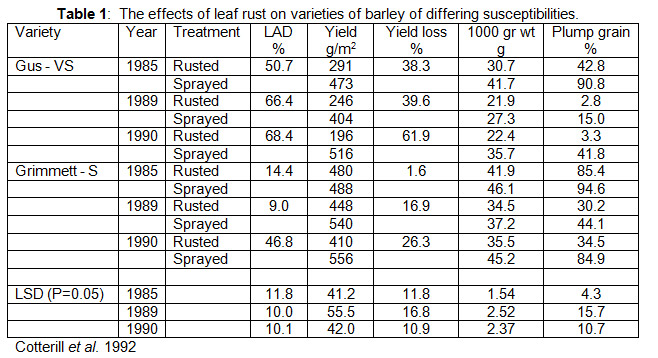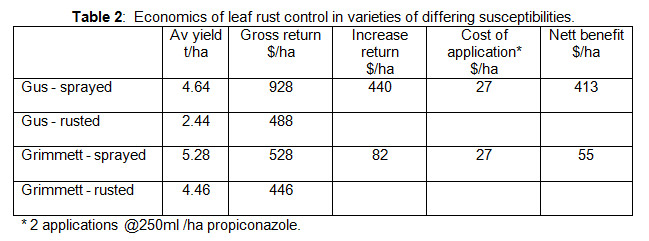LEAF RUST IN BARLEY - LESSONS LEARNT IN 2009 AND IMPLICATIONS FOR MANAGEMENT PLANS IN 2010
| Date: 21 Sep 2010

At this meeting in 2009, QPIF issued a warning that leaf rust (Puccinia hordei) was a potential threat to the 2009 barley crop. Fortunately, widespread epidemics did not materialise due mainly to unfavourable weather conditions. However the disease was present throughout the region and fungicide was applied to some crops in Queensland to control the disease.
New pathotype
In March, 2009, a sample of leaf rust from barley at Legume, NSW was sent to the Plant Breeding Institute (PBI) at Cobbitty for pathotype determination. This isolate proved to be a new pathotype with virulence for the resistance gene Rph3. This represented the first record of virulence on this gene in Australia. The new pathotype was designated 5457P+ and was clearly a single step mutation from the Grout attacking strain 5453P+. (Cereal Rust Report 2009)
The immediate commercial impact of this development is only minor as Fitzroy is currently the only variety in the North carrying this resistance gene; however virulence on Rph3 has had a serious effect on the breeding program. The gene was being used extensively as a source of resistance and its breakdown rendered many lines in the program susceptible.
Barley Breeding Australia – North works closely with the Plant Breeding Institute (PBI), Cobbitty to develop rust resistant barleys. Annually, around 500 lines are sent to PBI for field and glasshouse screening. Detection of pathotype 5457P+ pre-season, allowed PBI to use the new isolate in both their glasshouse and field screening in 2009. The data has identified lines that were relying on Rph3 alone for leaf rust resistance and most of these have been culled from the program.
Fortunately, BBA-North has been using alternative sources of leaf rust resistance for several years and although a large proportion of our material carried Rph3 there are lines with resistances effective against this new pathotype in the program. Lines carrying these resistances will be fast tracked in the program and will constitute the lion’s share of material being advanced in 2010.
Several samples of leaf rust were collected throughout the season to monitor the spread of this new pathotype. Except for one isolate from Attunga in NSW early in the season, all isolates collected through winter were of the old pathotype. In early October’ the new pathotype was identified in our screening nursery at Cleveland in Brisbane. It was subsequently isolated from our trial sites at Gatton and Toowoomba, indicating that the rust had increased and spread at least throughout south east Queensland. It is considered that pathotype 5457P+ will be endemic in the North in the 2010 season.
The lessons that can be learned from the detection of this new pathotype are:-
1 High levels of rust inoculum often lead to the development of new virulence’s
2 Breeding programs need to maintain diversity in the resistances being used
3 Pathotype 5453P+ dominated in 2009 yet 5457P+ increased and spread later in the season and
4 Varieties that were protected from leaf rust by Rph3 must now be considered susceptible.
Commercial examples
There were a number of crops sprayed with fungicide to control leaf rust in 2009. The following information is drawn from experiences with four of them and gives an insight into control of the disease in 2010.
1 Crop 1 Jondaryan – var. Grout
This crop was early sown in late April and was grown for silage. It was less than 500m from a paddock where barley (variety unknown, possibly Corvette) was sown even earlier as a cover crop for lucerne. This crop was under a centre pivot irrigator. When rust was detected in the Grout crop, the earlier crop had been cut for hay and there were low levels of leaf rust detected on plants that had missed cutting.
The crop had been sold for silage to a nearby dairy but when the client became aware of the presence of rust he cancelled the sale. The grower was able to find an alternative market. The crop yielded 9.8t / Ha of silage and the chopper was reportedly “red with rust”.
2 Crop 2 Millmerran - var. Grout
This was another early sown crop grown under a centre pivot irrigator. The crop was being monitored for spot form net blotch when mottling on the leaves alerted the agronomist to the presence of leaf rust. This was at the boot stage and propiconazole was applied at 500mL/Ha. Grower and agronomist were happy with the outcome.
3 Crop 3 Texas – var. Grout
This crop was sown in early July and grown under centre pivot irrigation. It had 150kg of urea applied in 3 split applications by fertigation. Rust was observed on 7 October with a comment of “rust mid canopy with some appearing on flag”. Propiconazole was applied by fertigation at 500mL/Ha with the result quoted as “magic”. The crop yielded 6.4t/Ha.
4 Crop 4 Macalister – var. Mackay
As far as we are aware this is the only crop of Mackay that was sprayed for control of leaf rust. Grown under dryland conditions, it was sown on 6 June and rust infection was first noticed in early September. The crop was sprayed on 17 September at 250mL/Ha of propiconazole. The foliar spray “did a good job” and the crop yielded 5.8t/Ha with a test weight of 67kg/Hl and screenings of 2%.
What do these examples tell us?
Three of the four crops were Grout which reflects its susceptibility to the disease and the large market share it commands. This does not mean that we should not sow Grout as it is still arguably the best suited variety to our region. However, it is a warning that, if you are sowing Grout in 2010, monitor your crops for the presence of leaf rust, particularly during stem elongation. If the rust is detected early, control measures can be implemented to avoid yield loss.
At least two of the crops were sown early; so that the crop was growing at a time of the year when temperatures are mild and wet periods through dews and fogs are normally frequent. These conditions favour rust development. The earlier barley is sown the greater the likelihood that it will be vulnerable to over-summering inoculum.
Two of these crops were under irrigation demonstrating the influence of environment on rust development. Moisture applied through irrigation not only provides a wet period directly; but also provides a sink of moisture in the crop that will generate further dews and an environment suitable for infection when temperatures are favourable.
The example of the Mackay crop is puzzling. Mackay has Adult Plant Resistance (APR) to leaf rust, which appeared quite effective in epidemic situations in 2008. In our nurseries in 2009, it again demonstrated a good level of resistance; however there were sufficient levels of rust in this crop for the grower to apply propiconazole.
It has since been learned that there were two crops of Grout within less than 1km of this crop and both were heavily rusted. It appears that the high inoculum load reaching the Mackay crop from the infected Grout crops resulted in sufficient rust development prompt a foliar spray. This may or may not have been warranted. Mackay should still be regarded as resistant to leaf rust but in some situations leaf rust may develop.
The Mackay crop seems to be a casualty of other infected crops in the vicinity. It is also postulated that the inoculum in Crop 1 is most likely to have come from the barley cover crop, 500m down the road. Again this highlights the dogma that rusts are social diseases. We are not farming in isolation. What happens on a particular farm can influence the welfare of other farms within the district.
Finally foliar applied propiconazole was effective in controlling leaf rust in these crops. While the 500 mL/Ha rate was applied to 2 of the crops, the 250mL rate gave good control in Crop 4. Rusts are much easier to control with foliar fungicides than leaf spot diseases and the 250mL rate of propiconazole or equivalent alternative product should be effective in most situations. If leaf rust is during elongation, particularly in Grout , two split applications of 250mL should prevent any yield loss.
Implications for management plans in 2010.
• Avoid sowing susceptible varieties early
• Monitor crops for presence of leaf rust from early noding paying particular attention to lower leaves
• Apply fungicides to protect a minimum of the last three leaves. In very susceptible varieties this may mean split applications at GS32/33 and again after GS39.
• Mackay and Shepherd have the best leaf rust resistance of current commercial varieties in the North. The new release Oxford is resistant.
Table 1 summarises results of trials to determine the effects of leaf rust on varieties with different levels of resistance. Controlling leaf rust in these trials increased average yields in Gus by 90% and in Grimmett by 18%.
Economics
Assuming the cost of fungicide is $22/L, application is $8/L and the price of barley is $200/tonne, the net benefit from controlling leaf rust in these trials is given in Table 2. The figures emphasise the importance of disease control in a very susceptible variety.

Contact details
Greg Platz
Department of Employment, Economic Development and Innovation.
Hermitage Research Station, 604 Yangan Road, Warwick QLD 4370
Ph: 07 4660 3633; Mob; 0408 733 055
Fax: 07 4660 3600
Email: Greg.platz@deedi.qld.gov.au
GRDC Project Code: DAQ00110. – Barley,
Was this page helpful?
YOUR FEEDBACK
